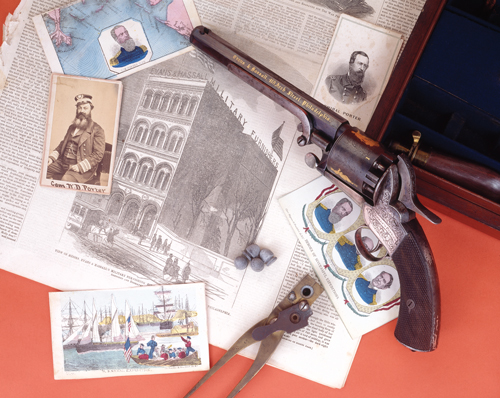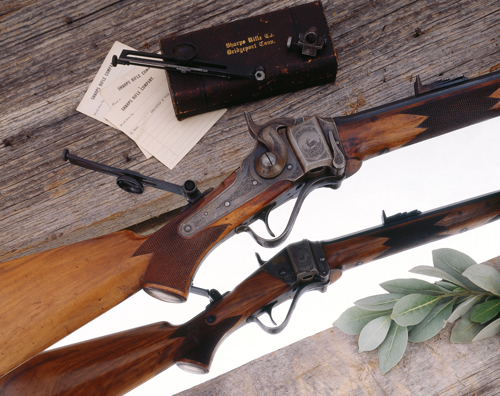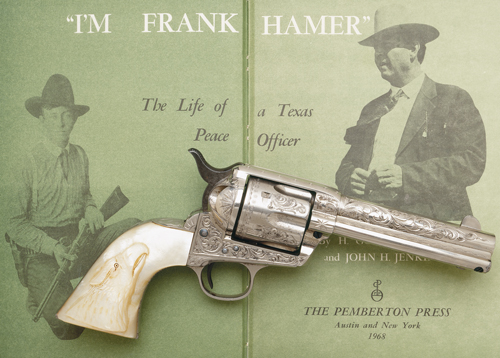There comes a time in every collector’s life when he has to sell a gun or guns, or just try his hand at turning a profit. No matter how great the protestation everybody meets the situation face to face at one time or another.

There comes a time in every collector’s life when he has to sell a gun or guns, or just try his hand at turning a profit. No matter how great the protestation, “… I never sell a gun … I will never sell a gun … I never sold a gun,” everybody meets the situation face to face at one time or another. It is difficult to understand why a certain few collectors make a fetish of the claim that they never sold a piece, as if to do so were beneath one’s dignity.
You will meet these types often, but only rarely are their protestations credible. Some collectors are really more dealers than collectors; at least their buying, selling and trading activities run at a fever pitch, and they never seem to settle into any collecting pattern. A great majority of collector sales are due to a wide range of reasons, e.g., up-grading of specimens, disposing of items that no longer hold an interest, or a pressing and immediate need for cash. A number of for-sale methods are available depending on the time and effort one wishes to take. First to note is that the “book” or advertised or listed price for a specific piece is not always the one that can be realized for it.
In some cases there may be no takers for the piece at any price. At this point the collector may acquire a quick education — and a most lasting impression — of one more detail of the fine art of gun trading!
Setting forth a listing in this book and neatly assigning a value to each piece tends very much to be misleading, especially to the neophyte or only casually interested owner of a gun or two. This is not unique to antique arms, but holds true for any collecting field. The mere fact that a gun is listed with a price in no way precludes that the owner must achieve that figure or even a predetermined percentage thereof. No central market place or bourse exists where all gun dealers and collectors conduct their transactions as on the stock or commodity exchanges; the arrangement is much looser with a great many variables; hit-or miss is a more apt description.
To avoid disappointment it is well to understand and be aware of the peculiarities and complexities involved in evaluating collectors’ firearms. Owning a rare gun with a healthy dollar value and realizing that value is at times analogous to “… being a horse of another color!” The collector should be aware that one gun is not as easily sold as another and that the demand factor greatly influences price and marketability.
True, a great many very rare American guns are worth in the many hundreds or thousands of dollars; many will be seen listed in this work. Those pieces quite definitely fetch those prices when sold to a retail customer. The number of collectors for some of those particular type guns, however, may be extremely limited; as such, it is possible to occasionally experience not only sales resistance to a gun, but considerable lethargy as well. Possibly the only way that that particular piece might be sold would be to lower the price to a figure so attractive that it would be tantamount to forcing a sale.
The same can hold true of a quite rare and valuable gun that is in great demand, but is in a very low grade of condition. On the assumption that the collector has bought wisely and ably, he might well find that a dealer will pay him as high a price or more than any collector in the area. The dealer’s own specialized clientele and access to a national market allows him to know exactly where to place that gun quickly, and in such instances he is usually willing to pay a premium price. The dealer normally pays cash on the spot for the item, whereas in many cases of private sales, the collector has to accept trade items in lieu of money.
There is no general guide as to what gun dealers pay for their merchandise. To flatly state that they pay 50 percent of market value or to assign any fixed percentage would be absolutely erroneous. The only accurate statement is — a dealer expects to make a profit! With very fine conditioned pieces, numerous rare models and certain types for which he has a special demand (and for any number of other reasons), the dealer is often in the position to pay the highest price for a piece and work on an extremely small profit margin to get it. This has been especially true in recent years. The dealer might even pay the so-called “book” value for a piece as he has been commissioned by a client to specifically acquire that model for a premium price. On the other hand, if that dealer has no demand or clientele for certain types of arms, then regardless of price, he might not want to invest money at all as it would represent completely dead merchandise for him.
Many dealers are specialists themselves and handle only certain types for which they have an immediate following and will completely pass by pieces that are not of interest to them regardless of price. There are no generalizations that will apply to the subject of all arms dealers. A quite interesting observation is the fact that a tremendous amount of business is generated between dealers themselves, since most have their own followings and customers. If the dealer operates on a large scale and in mail order or makes all the major gun shows throughout the country, thus having access to a national market, it is obvious that he will have a wider range of interest and broader coverage of antique arms than the dealer who is conducting his business strictly on a local basis. In the latter case, the dealer will normally pay highest prices only for those pieces for which he has a walk-in local trade, whereas other items would be attractive to him only if they could be acquired well under “book” value allowing for wholesaling to other dealers.
As a general statement, the larger the dealer and the broader his scope and sales coverage, the higher the prices he is willing to pay for merchandise. If the collector does not realize the price he expected from a dealer or fellow collector, five other options are open to him for selling that arm at the greatest possible figure. Each requires time and effort on his part, but the results may prove worthwhile. The easiest method is to take space at a regularly scheduled gun show and display the arms to be sold as attractively as possible.
A good opportunity is afforded to sell or trade there providing the price is realistic. Through actual show experience, where feverish trading often occurs, the collector will come across and very likely take for his own use much of the banter heard about the floor. Eavesdrop on any large gun show and chances are one will hear a chorus or two of the following elucidations during the course of the day, “… That’s less than I paid for it! … I don’t care if I sell it or not! … That’s less than I got in it! … I got more than that in it! … If it doesn’t move, you can bring it back!”

Putting Firearms On Consignment
Consignment is another method that can be utilized to realize a higher value from a collector’s gun. Many dealers will accept certain select pieces from their clientele to sell on this basis. Consignment allows the dealer to add to his stock, permitting a broader selection of merchandise, without having to invest capital. Because of this, the dealer is willing to realize more for the collector than he would be willing to pay cash on the spot. The collector agrees to leave his gun with the dealer for sale at an agreed upon retail price. Details should be clearly understood, and the agreement made in writing.
The collector further agrees to allow the dealer a flat percentage fee (normally about 20 percent) of the retail price if the item is sold. Should the item not be sold after a specified time, the collector has the right to take it back and to dispose of it at his own discretion. Normally, no charges are made to the collector if the piece is not sold, unless previously agreed upon. All these factors, especially the matter of the commission fee, should be definitely committed to writing at the time the consignment is made.
A great many fine firearms are sold by this method. Advantages are obvious for both owner and seller. However, to utilize this method successfully one must choose wisely the dealer who is to handle the item. Most dealers are not interested in taking insignificant, low value items on consignment; e.g., pieces worth $100 or less; nor questionable objects requiring guarantees to their clientele while the consignee is relieved of all responsibility.
Important in the choice of a consignment dealer is one that is not only reputable, but is financially reliable. In many instances the dealer sells his items on a time payment method (that is, the money comes in in dribs and drabs), or a trade may be necessary to realize the best transaction.
In such instances it is important that the dealer pays the consignee the full agreed upon price the moment disposal is made, regardless of how he was paid for it or whether a trade was involved. Regrettably in many instances, consignment has proven an unpleasant experience for the collector as it was found that the dealer selling on a time payment method could not come up with all the money by the time the final payment came in.
A trade situation also can prove to be a similar problem. It may be necessary where trading is involved that the consignee must sweat it out until each of the pieces taken in trade are themselves sold; sometimes an almost endless process. Thus, choose wisely and be sure to commit the agreement to writing.

Advertising in Gun Publications
The sales option requiring the greatest amount of time, but reaching the widest possible audience, is advertising the gun in one or more of the collecting periodicals. These are widely circulated throughout the United States and abroad, and present the collector with the very best chance of finding the ultimate specialized buyer most actively seeking that particular piece. Bear in mind that a considerable time lapse exists in mail order selling, from placing the advertisement to the date of publication and circulation; normally a minimum of two months. The collector must be prepared to service and answer all inquiries as well as to give full cash refund should the piece be returned by the buyer if not found up to specifications.
Not a few wellknown dealers active today started off by dabbling in part-time mail order. A cautionary note must be made with regard to buying and selling firearms of all types — especially through the mail: One must be familiar with the text of the Federal Firearms Act of 1968, which regulates interstate trade in firearms, and to be equally familiar with local and state firearms ordinances — decidedly a mixed bag! In the most general terms, guns made prior to December, 1898 are free of regulations under the Federal Act, but they do not conflict with or cancel any existing state or local laws in effect in one’s area.
The laws are readily available and their finer points can be checked with local gun clubs and organizations conversant with firearms regulations.

Trading a Gun
Trading as a final option. If all else fails, there’s always gun swapping! Probably no other collecting hobby affords as many opportunities to trade as does antique firearms. This time honored method is also a means of sharpening one’s wits. With not a few collectors their major interest in the hobby is the action and satisfaction derived from the pure trading aspects.
Depending on technique, it is very possible to amass quite an impressive collection with a minimum expenditure of cash and a little ingenuity and Yankee horse-trading. Likely superfluous would be a caution about trading values, but inasmuch as “… some never get the word” (to summarize an old story), only the reminder will be issued here that highly unrealistic prices are often encountered in the area where trading rather than sales is anticipated.
The reason for this might possibly be the psychological advantage thought in allowing someone more for his gun in trade than could be attained for it in cash. The whole thing is based on both a not-too-cute or clever and often selfdeceiving principle and brings to mind the classic story of the two $500 alley cats traded for the $1,000 mongrel dog!

Next Step: Get your FREE Printable Target Pack
Enhance your shooting precision with our 62 MOA Targets, perfect for rifles and handguns. Crafted in collaboration with Storm Tactical for accuracy and versatility.
Subscribe to the Gun Digest email newsletter and get your downloadable target pack sent straight to your inbox. Stay updated with the latest firearms info in the industry.

![Best Concealed Carry Guns In 2025 [Field Tested] Wilson Combat EDC X9S 1](https://gundigest.com/wp-content/uploads/Wilson-Combat-EDC-X9S-1-324x160.jpg)


![Best 9mm Carbine: Affordable PCCs [Tested] Ruger Carbine Shooting](https://gundigest.com/wp-content/uploads/Ruger-Carbine-Shooting-100x70.jpg)
![Best AR-15: Top Options Available Today [Field Tested] Harrington and Richardson PSA XM177E2 feature](https://gundigest.com/wp-content/uploads/Harrington-and-Richardson-PSA-XM177E2-feature-100x70.jpg)

I have a Waffenfa Brik Bern M78 rifle that I would like to sell what is it worth thanks